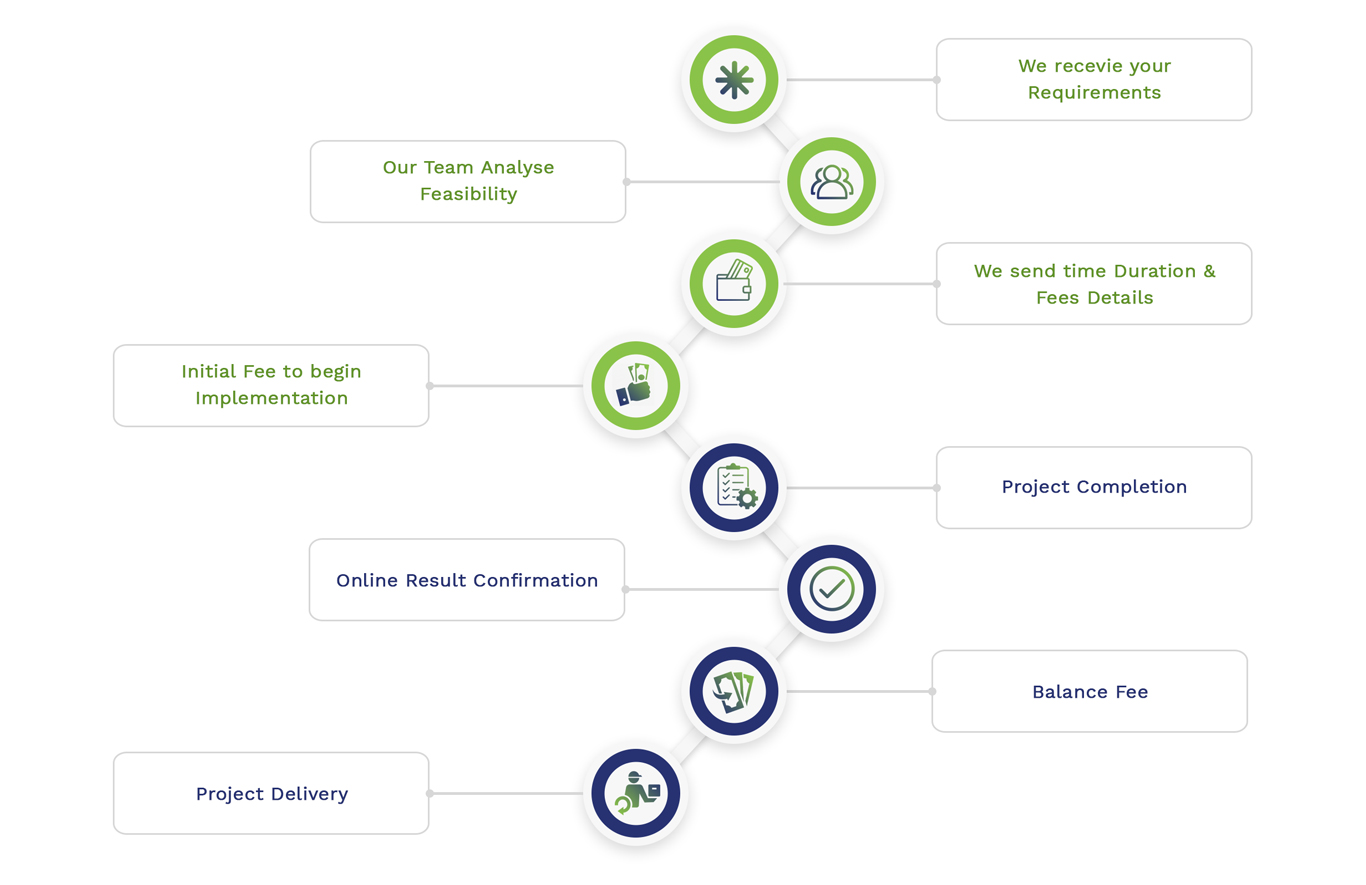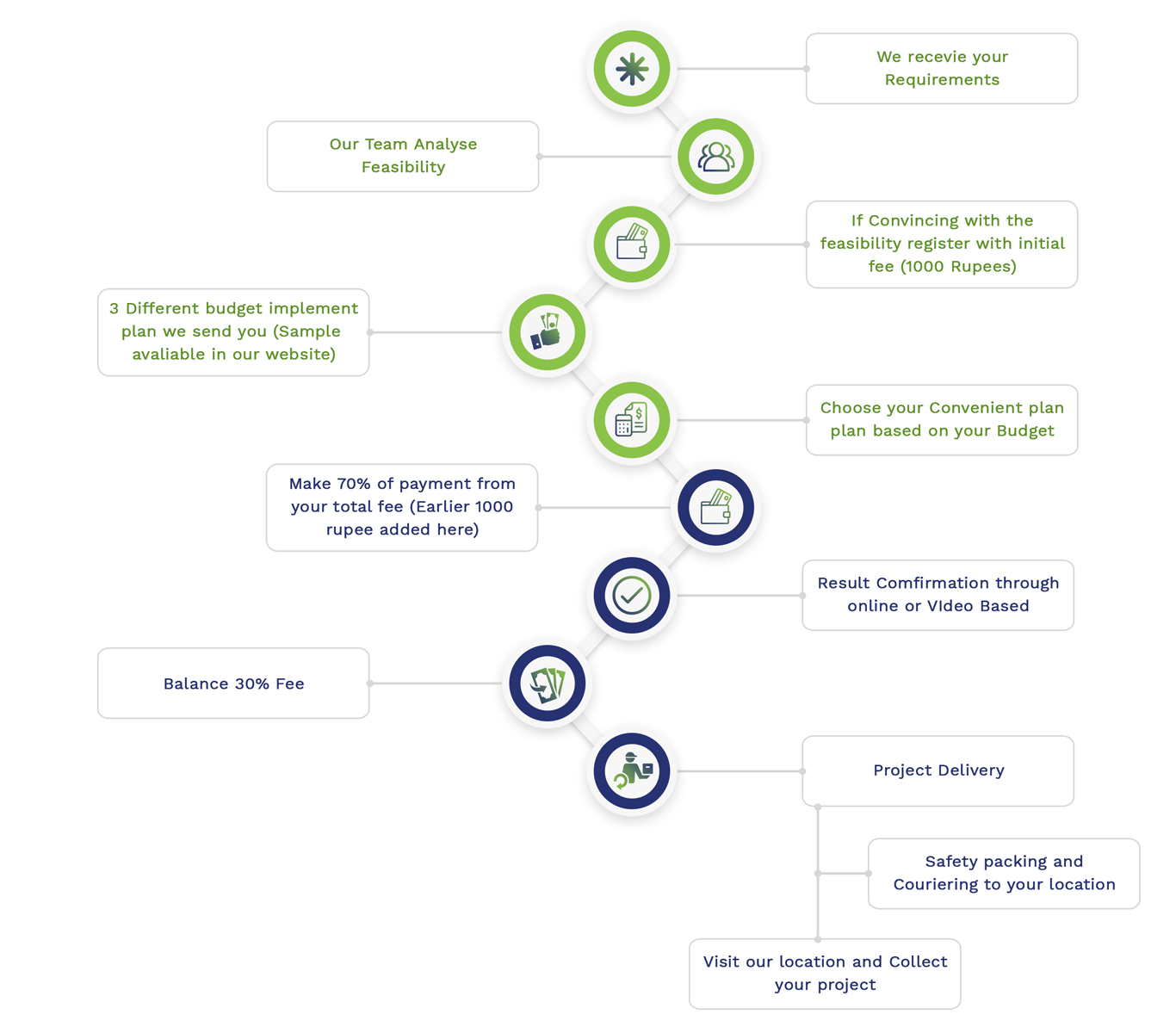Circuit Simulation Python
Circuit Simulation Python we have numerous techniques that are useful for carrying out circuit simulation in an effective manner, if you face any difficulties then you can share with us all your research requirements to matlabprojects.org. We have all the latest resources and technical team support to guide you with best quality and in effective manner. We recommend a few usual approaches, algorithms, and instance projects for circuit simulation by means of employing Python:
Libraries for Circuit Simulation
- SciPy
- Methods: integrate.odeint(), scipy.linalg
- Outline: For resolving differential equations and linear algebra issues, Scipy library is examined as beneficial.
- NumPy
- Methods: linalg.solve(), numpy.array()
- Outline: NumPy effectively addresses the systems of complicated linear equations and it involves specific array functions.
- SymPy
- Methods: Matrix(), sympy.solve()
- Outline: For resolving the circuit equations in a logical manner, implement the symbolic mathematics.
- PySpice
- Methods: Probe, PySpice.Spice.Library
- Outline: For SPICE simulators, it provides a python interface.
- LTspice (via LTspice Control Library)
- Methods: parse(), ltspice.LTSpice()
- Outline: Generally, for circuit simulation, communicate with LTspice.
Techniques and Methods
- DC Analysis
- Approaches: The linear equations which depict the circuit have to be resolved.
- Methods: linalg.solve(), numpy.linalg.solve()
- AC Analysis
- Approaches: Through the utilization of phasors, we plan to explore the reaction of the circuit to AC signals.
- Methods: fft.fft(), complicated number operations
- Transient Analysis
- Approaches: In order to define the time-dependent activity of the circuit, focus on resolving differential equations.
- Methods:integrate.solve_ivp(), scipy.integrate.odeint()
- Frequency Response Analysis
- Approaches: In what manner the circuit reacts to various frequencies should be examined.
- Methods: signal.freqz(), numpy.fft.fft()
- Symbolic Analysis
- Approaches: As a means to acquire the equations of the circuit, concentrate on employing symbolic computation.
- Methods: Matrix(), sympy.solve()
Instance Projects
Instance 1: Simple DC Circuit Analysis
Goal: Through the utilization of Kirchhoff’s Current Law (KCL), we plan to determine the node voltages in a basic resistive circuit.
Circuit:
R1
(V1)—/\/\—(V2)
|
R2
|
(GND)
Python Code:
import numpy as np
# Define the resistances and voltage sources
R1 = 1000 # 1k ohm
R2 = 2000 # 2k ohm
V1 = 5 # 5V
# Set up the equations based on KCL
# V1/R1 + V2/R2 = 0
# V1 – V2 = 5
A = np.array([[1/R1, 1/R2], [1, -1]])
B = np.array([0, V1])
# Solve for node voltages
voltages = np.linalg.solve(A, B)
print(f”Node Voltages: V1 = {voltages[0]:.2f} V, V2 = {voltages[1]:.2f} V”)
Instance 2: Transient Analysis of an RC Circuit
Goal: In an RC circuit, our team focuses on simulating the discharging and charging of a capacitor.
Circuit:
V_in
___
( )—/\/\—+—( V_out )
— R1 | C1
GND ( )
—
GND
Python Code:
import numpy as np
import matplotlib.pyplot as plt
from scipy.integrate import odeint
# Define the component values
R1 = 1000 # 1k ohm
C1 = 1e-6 # 1uF
# Define the input voltage as a step function
def V_in(t):
return 5 if t >= 0 else 0
# Define the differential equation for the RC circuit
def rc_circuit(V_out, t, R1, C1):
dV_out_dt = (V_in(t) – V_out) / (R1 * C1)
return dV_out_dt
# Time points
t = np.linspace(0, 0.01, 1000)
# Initial condition
V_out_0 = 0
# Solve the differential equation
V_out = odeint(rc_circuit, V_out_0, t, args=(R1, C1))
# Plot the results
plt.plot(t, V_out)
plt.xlabel(‘Time [s]’)
plt.ylabel(‘V_out [V]’)
plt.title(‘Transient Response of an RC Circuit’)
plt.grid()
plt.show()
Instance 3: Frequency Response of an RLC Circuit
Goal: Generally, the frequency reaction of a sequence RLC circuit should be examined.
Circuit:
V_in
___
( )—/\/\—+—( V_out )
— R1 | L1
GND ( )
—
|
—
C1
|
GND
Python Code:
import numpy as np
import matplotlib.pyplot as plt
from scipy.signal import freqz
# Define the component values
R1 = 1000 # 1k ohm
L1 = 1e-3 # 1mH
C1 = 1e-6 # 1uF
# Define the frequency range
w = np.logspace(1, 6, 1000)
# Calculate the impedance of each component
Z_R = R1
Z_L = 1j * w * L1
Z_C = 1 / (1j * w * C1)
# Calculate the total impedance
Z_total = Z_R + Z_L + Z_C
# Calculate the transfer function H(w) = V_out / V_in
H = Z_C / Z_total
# Plot the magnitude and phase response
fig, (ax1, ax2) = plt.subplots(2, 1, figsize=(8, 6))
ax1.semilogx(w, 20 * np.log10(np.abs(H)))
ax1.set_title(‘Frequency Response of a Series RLC Circuit’)
ax1.set_ylabel(‘Magnitude [dB]’)
ax1.grid()
ax2.semilogx(w, np.angle(H))
ax2.set_xlabel(‘Frequency [rad/s]’)
ax2.set_ylabel(‘Phase [radians]’)
ax2.grid()
plt.show()
Advanced Instance: Using PySpice for SPICE Simulation
Goal: As a means to communicate with a SPICE engine, we intend to simulate an RC circuit with the aid of PySpice.
Python Code:
from PySpice.Spice.Library import SpiceLibrary
from PySpice.Probe.Plot import plot
from PySpice.Spice.NgSpice.Simulation import NgSpiceShared
from PySpice.Spice.NgSpice.Shared import NgSpiceShared
# Initialize the PySpice library
spice_library = SpiceLibrary(‘/path/to/spice/models’)
# Create a circuit and simulate
circuit = Circuit(‘RC Circuit’)
circuit.V(1, ‘in’, circuit.gnd, 5@u_V)
circuit.R(1, ‘in’, ‘out’, 1@u_kΩ)
circuit.C(1, ‘out’, circuit.gnd, 1@u_μF)
# Set up the simulator
simulator = circuit.simulator(temperature=25, nominal_temperature=25)
analysis = simulator.transient(step_time=1@u_us, end_time=10@u_ms)
# Plot the results
figure, axe = plt.subplots(figsize=(10, 6))
plot(analysis[‘out’])
plt.xlabel(‘Time [s]’)
plt.ylabel(‘V_out [V]’)
plt.title(‘Transient Response of an RC Circuit’)
plt.grid()
plt.show()
Important 50 circuit simulation python Project Topics
There exist several circuit simulation Python project topics, but some are examined as significant. We provide some crucial projects that encompass a scope of uses and complications, by offering numerous possibilities to investigate different factors of circuit simulation:
Basic Circuit Simulation Projects
- DC Circuit Analysis
- Explanation: By means of employing Ohm’s Law and Kirchhoff’s Current Law (KCL), we focus on determining the node voltages in a basic DC resistive circuit.
- AC Circuit Analysis
- Explanation: With the aid of phasors, our team aims to investigate the activity of AC circuits. In the frequency range, it is appreciable to determine currents and voltages.
- Series and Parallel Circuits
- Explanation: Generally, parallel and series resistor circuits ought to be simulated. We plan to assess associated resistances.
- Voltage Divider
- Explanation: Our team aims to simulate a voltage divider circuit in an effective manner. For various resistor values, it is significant to examine the output voltage.
- Current Divider
- Explanation: A current divider circuit must be simulated. It is approachable to assess the current across every branch.
- RC Circuit Transient Analysis
- Explanation: Through the utilization of differential equations, we intend to simulate the discharging and charging of a capacitor in an RC circuit.
- RL Circuit Transient Analysis
- Explanation: The temporary reaction of an RL circuit has to be simulated. Periodically, our team plans to examine the inductor current.
- RLC Circuit Transient Analysis
- Explanation: Typically, the temporary reaction of an RL circuit must be simulated. Our team plans to investigate the fluctuating motion.
- Frequency Response of RC Circuit
- Explanation: We focus on examining the frequency reaction of an RC high-pass and low-pass filter.
- Frequency Response of RLC Circuit
- Explanation: The frequency reaction of a parallel and series RLC circuit must be simulated and examined.
Intermediate Circuit Simulation Projects
- Band-Pass and Band-Stop Filters
- Explanation: With the support of RLC elements, we intend to model and simulate band-stop and band-pass filters.
- Impedance Matching
- Explanation: Mainly, impedance matching networks should be simulated. In enhancing transmission of power, our team focuses on examining their performance.
- Operational Amplifier (Op-Amp) Circuits
- Explanation: The fundamental op-amp arrangements such as non-inverting, inverting, and differential amplifiers must be simulated.
- Oscillator Circuits
- Explanation: We aim to model and simulate oscillator circuits like Colpitts oscillators and RC phase shift.
- 555 Timer Circuits
- Explanation: In monostable and unstable manners, our team plans to simulate 555 timer circuits. The output waveforms should be explored.
- Differential Amplifier
- Explanation: A differential amplifier circuit ought to be simulated. It is significant to investigate its common-mode rejection ratio (CMRR) and differential gain.
- Active Filters
- Explanation: By means of utilizing op-amps like band-pass, low-pass, and high-pass filters, we focus on modeling and simulating active filters.
- Power Supply Design
- Explanation: Including filtering, rectification, and voltage regulation phases, it is appreciable to simulate a DC power supply circuit.
- Voltage Regulators
- Explanation: Generally, linear and switching voltage regulators should be simulated. Our team plans to examine their effectiveness.
- Transformer Simulation
- Explanation: We focus on simulating the process of a transformer. The current and voltage conversion has to be investigated.
Advanced Circuit Simulation Projects
- Noise Analysis in Circuits
- Explanation: In electronic circuits, we intend to simulate and examine the impact of noise.
- Non-Linear Circuit Simulation
- Explanation: By means of non-linear elements such as transistors and diodes, our team plans to simulate circuits.
- Digital Logic Circuits
- Explanation: The fundamental digital logic gates and digital circuits must be simulated.
- Sequential Logic Circuits
- Explanation: We focus on simulating shift registers, flip-flops, and counters.
- Analog-to-Digital (ADC) and Digital-to-Analog (DAC) Converters
- Explanation: Typically, DAC and ADC circuits have to be simulated. We aim to investigate their effectiveness.
- Phase-Locked Loop (PLL)
- Explanation: It is approachable to simulate a PLL circuit. Our team aims to examine its lock range and flexibility.
- Switched-Capacitor Circuits
- Explanation: Generally, switched-capacitor circuits must be simulated. We focus on examining their process.
- Signal Modulation and Demodulation
- Explanation: The FM and AM modulation and demodulation circuits have to be simulated.
- Power Electronics Circuits
- Explanation: Our team aims to simulate motor drive circuits, DC-DC converters, and inverters.
- RF Circuit Simulation
- Explanation: Mainly, RF circuits such as filters, amplifiers, and mixers should be simulated.
Specialized Circuit Simulation Projects
- Biomedical Instrumentation Circuits
- Explanation: The circuits employed in biomedical applications should be simulated. It could involve ECG biosensors and amplifiers.
- Sensor Interface Circuits
- Explanation: For communicating with different sensors such as light, temperature, pressure, we intend to simulate circuits.
- Battery Management Systems
- Explanation: The circuits utilized for battery management such as charging and protection circuits must be simulated.
- Photovoltaic (Solar) Systems
- Explanation: The electrical features of photovoltaic cells and models ought to be simulated.
- Electric Vehicle (EV) Charging Circuits
- Explanation: For EV charging models, focus on simulating circuits.
- Energy Harvesting Circuits
- Explanation: For gathering energy from surrounding resources like thermal, sound, vibrational, we plan to simulate circuits.
- IoT Node Power Management
- Explanation: Mainly, for low-power IoT devices, our team aims to simulate power management circuits.
- High-Frequency Circuit Simulation
- Explanation: The high-frequency circuits must be simulated. We aim to examine their effectiveness.
- EMI/EMC Simulation
- Explanation: In circuits, our team focuses on simulating electromagnetic interference (EMI) and compatibility (EMC) problems.
- PCB Design and Simulation
- Explanation: For different uses, we plan to model and simulate printed circuit boards (PCBs).
Python-Specific Circuit Simulation Projects
- PySpice-based Circuit Simulation
- Explanation: In order to simulate and examine different electronic circuits, it is beneficial to employ PySpice.
- LTspice Integration with Python
- Explanation: Generally, Python should be utilized to computerize and investigate LTspice simulations.
- Symbolic Circuit Analysis with SymPy
- Explanation: For symbolic exploration of electronic circuits, our team aims to utilize SymPy.
- Network Analysis with Python
- Explanation: Typically, complicated networks of inductors, resistors, and capacitors should be simulated and examined.
- Monte Carlo Simulation for Circuit Reliability
- Explanation: As a means to investigate the credibility of electronic circuits, it is advisable to employ Monte Carlo techniques.
- Machine Learning for Circuit Design
- Explanation: For reinforcing circuit design metrics, we intend to utilize machine learning methods.
- Optimization of Analog Circuits
- Explanation: To model analog circuits along with certain performance measures, it is beneficial to employ optimization approaches.
- Real-Time Circuit Simulation
- Explanation: With the aid of Python, our team plans to construct an actual time circuit simulation engine.
- Circuit Simulation GUI with Tkinter
- Explanation: For circuit simulation, it is appreciable to develop a graphical user interface by means of employing Tkinter.
- Custom SPICE-like Simulator in Python
- Explanation: Through the utilization of Python from scratch, we aim to create a conventional SPICE-like circuit simulator.
Encompassing a few general algorithms, approaches, instance projects, and 50 project concepts, a detailed note on circuit simulation with Python is provided by us which can be beneficial for you in creating such kinds of projects.
Subscribe Our Youtube Channel
You can Watch all Subjects Matlab & Simulink latest Innovative Project Results
Our services
We want to support Uncompromise Matlab service for all your Requirements Our Reseachers and Technical team keep update the technology for all subjects ,We assure We Meet out Your Needs.
Our Services
- Matlab Research Paper Help
- Matlab assignment help
- Matlab Project Help
- Matlab Homework Help
- Simulink assignment help
- Simulink Project Help
- Simulink Homework Help
- Matlab Research Paper Help
- NS3 Research Paper Help
- Omnet++ Research Paper Help
Our Benefits
- Customised Matlab Assignments
- Global Assignment Knowledge
- Best Assignment Writers
- Certified Matlab Trainers
- Experienced Matlab Developers
- Over 400k+ Satisfied Students
- Ontime support
- Best Price Guarantee
- Plagiarism Free Work
- Correct Citations
Expert Matlab services just 1-click

Delivery Materials
Unlimited support we offer you
For better understanding purpose we provide following Materials for all Kind of Research & Assignment & Homework service.
 Programs
Programs Designs
Designs Simulations
Simulations Results
Results Graphs
Graphs Result snapshot
Result snapshot Video Tutorial
Video Tutorial Instructions Profile
Instructions Profile  Sofware Install Guide
Sofware Install Guide Execution Guidance
Execution Guidance  Explanations
Explanations Implement Plan
Implement Plan
Matlab Projects
Matlab projects innovators has laid our steps in all dimension related to math works.Our concern support matlab projects for more than 10 years.Many Research scholars are benefited by our matlab projects service.We are trusted institution who supplies matlab projects for many universities and colleges.
Reasons to choose Matlab Projects .org???
Our Service are widely utilized by Research centers.More than 5000+ Projects & Thesis has been provided by us to Students & Research Scholars. All current mathworks software versions are being updated by us.
Our concern has provided the required solution for all the above mention technical problems required by clients with best Customer Support.
- Novel Idea
- Ontime Delivery
- Best Prices
- Unique Work
Simulation Projects Workflow

Embedded Projects Workflow



 Matlab
Matlab Simulink
Simulink NS3
NS3 OMNET++
OMNET++ COOJA
COOJA CONTIKI OS
CONTIKI OS NS2
NS2






